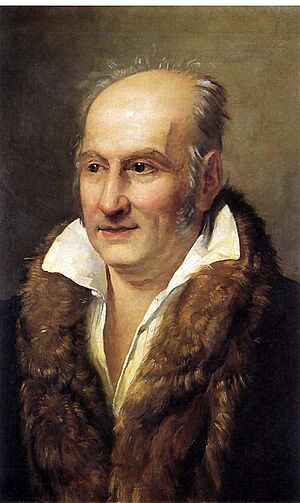Gian Domenico Romagnosi facts for kids
Quick facts for kids
Gian Domenico Romagnosi
|
|
|---|---|
 |
|
| Born | 11 December 1761 Salsomaggiore Terme
|
| Died | 8 June 1835 (aged 73) Milan
|
Gian Domenico Romagnosi (born December 11, 1761 – died June 8, 1835) was an important Italian thinker. He was a philosopher, an economist, and a jurist (someone who studies law). He is known for his ideas on law, society, and even for some early experiments with electricity.
Contents
Biography of Gian Domenico Romagnosi
Gian Domenico Romagnosi was born in Salsomaggiore Terme, Italy. He studied law at the University of Parma from 1782 to 1786. In 1791, he became the chief civil magistrate of Trento. A magistrate is like a judge or a high-ranking public official.
Trento was a city that changed hands many times. In the late 1700s and early 1800s, it was ruled by France, Italy, and Austria. In 1799, Romagnosi was arrested by the Austrians in Innsbruck. He was held for about 15 months because they thought he supported the French. However, he was found innocent.
In 1801, the French took control of Trento during the Napoleonic Wars. Romagnosi was then given an important job as Secretary of the Higher Council. He later became a professor of law at several universities, including Parma, Pavia, Pisa, and Milan.
After Napoleon's rule ended, Romagnosi lost his teaching job at the Milan university. But he continued to give lectures until 1817. In 1818, he was again put on trial in Venice for disloyalty, but he was found innocent once more. One of his students, Carlo Cattaneo, was greatly influenced by Romagnosi's ideas. Gian Domenico Romagnosi passed away in Milan in 1835.
His most famous work is Introduzione allo studio del diritto pubblico universale, which means Introduction to the Study of Universal Public Law.
Romagnosi's Electromagnetism Experiments
Even though Romagnosi was not mainly a scientist, he did some interesting experiments. He used a voltaic pile, which was an early type of battery. He studied how its electric charge affected a compass needle.
He published his findings in Italian newspapers in 1802. Some people believe he found a link between electricity and magnetism. This was almost two decades before Hans Christian Ørsted made his famous discovery of electromagnetism in 1820.
Romagnosi's experiments showed that an electrostatic charge from a voltaic pile could make a magnetic needle move. This was an important observation. Joseph Hamel, a historian, pointed out that Romagnosi's discovery was written about in a book called Manuel du Galvanisme (1805). This book clearly mentioned a "galvanic current" (courant galvanique).
Another book, Essai théorique et expérimental sur le Galvanisme (1804) by Giovanni Aldini, also mentioned Romagnosi's work. It said: "This new property of galvanism has been noted by other observers, and lately by M. Romanesi, a physicist in Trente, who recognized that galvanism made the magnetic needle decline." Aldini was also in touch with Ørsted at that time. This shows that Romagnosi's work was known in the scientific community.
Works
Romagnosi wrote many books and articles on law, philosophy, and economics. Here are some of his notable works:
- Genesi del diritto penale (Origin of Criminal Law), 1791.
- Introduzione allo studio del diritto pubblico universale (Introduction to the Study of Universal Public Law), 1803.
- Principi fondamentali di diritto amministrativo (Fundamental Principles of Administrative Law), 1814.
- Che cos'è la mente sana? (What is a Sound Mind?), 1827.
- Dell'indole e dei fattori dell'incivilimento con esempio del suo risorgimento in Italia (On the Nature and Factors of Civilization with an Example of its Revival in Italy), 1832.
Images for kids
See also
 In Spanish: Gian Domenico Romagnosi para niños
In Spanish: Gian Domenico Romagnosi para niños


